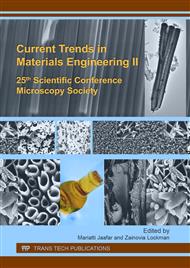p.190
p.194
p.198
p.202
p.206
p.211
p.215
p.220
p.224
Microstructural, Mechanical and Dielectric Properties of CCTO/Epoxy Composite
Abstract:
An attempt has been made to investigate the relationship between different composition of CaCu3Ti4O12 (CCTO)/epoxy to the microstructural, dielectric and mechanical properties respectively. CCTO powder had been produced through solid state reaction method using CaCO3, CuO and TiO2 as the raw materials. They were mixed at stoichiometric ratio and calcined at 1040°C for 10 hours. CCTO powder mixed with epoxy and hardener at different weight percentage (10, 20, 30, 40 and 50 wt%). Microstructure of fracture surface of the composite had been studied using Field Emission Scanning Electron Microscopy (FESEM) and mechanical characterization had been conducted using Universal Testing Machine (UTM). LCR meter Agilent 4284A was used to measure the dielectric properties at 20 Hz to 1 MHz. Increasing CCTO concentration to the composite caused a significant change of dielectric constant which arised from 17.1 to 23.5 at 1 kHz. This arising due to higher concentration of CCTO filler transfer more intrinsic values to the composite. Tensile test shows an increment to stress value from 4 to 17 MPa as the respond on increasing of ceramic filler concentration. High stiffness of CCTO have increased the strength of the composite. The dispersion of higher weight percentage of the CCTO into the epoxy is more compacted than the dispersion of lower weight percentage of CCTO. It is best to mix the higher amount of filler into the polymer matrix to increase the dielectric and strength of the composite material.
Info:
Periodical:
Pages:
206-210
Citation:
Online since:
September 2017
Keywords:
Price:
Сopyright:
© 2017 Trans Tech Publications Ltd. All Rights Reserved
Share:
Citation:


